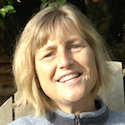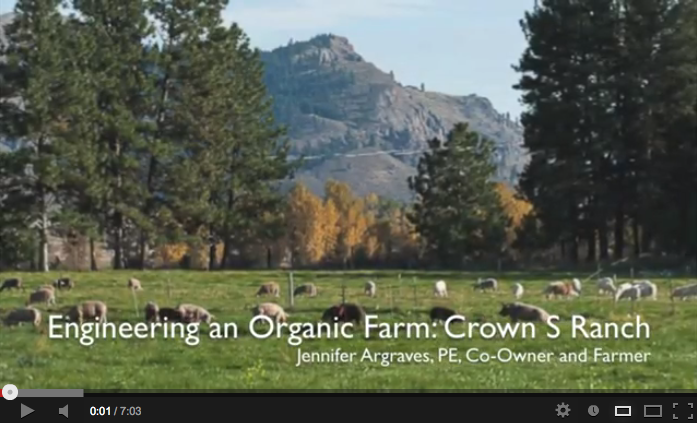Jennifer Argraves, Crown S Ranch, talks about the farm that she and her husband, Louis Sukovaty, own and manage. Jennifer tells us about how they raise and market beef cattle, pigs, sheep, turkeys, broiler chickens, and eggs. Below the video you will find a transcript of the audio if you prefer to read along.
Crown S Ranch – A Farm Introduction (A transcript of the video above.)
I’m Jennifer Argraves, and my husband, Louis Sukovaty, and I run Crown S Ranch here in the Methow Valley in Winthrop, Washington. We farm about 150 acres; and on our 150 acres we rotationally graze beef, pigs, chickens, turkeys and sheep. We also grow our own organic grain and hay. The grain is for the animals that eat grain and we grow all of our own organic hay.
The way that we farm is, we farm in terms of systems or cycles. Our motto is: Better for the animals, better for the environment, better for you. So when we take an animal onto our farm, the first thing we do is we try to find a habitat that is right for that animal, like, how does that animal thrive? What is it that makes that animal healthy? For beef, for example, what they’re the most healthy at, is entirely grass fed and finished. They rotate throughout our pasture system every 18 to 24 hours and they are followed by chickens with both laying hens who are able to pick up horn flies and face flies in the larvae state out of the manure pads.
They are also followed by our pigs are our rototillers, our sheep graze a little differently. And each of these animals, what it does is it’s a layered-type of system, so on one acre of land, you are building topsoil. You have clean air, fresh water, you’re carbon sink and you are actually able to raise more meat – more – food because you are also getting fertilizer for vegetables, more food than you can in any industrial-type system.
We are engineers by trade and the way we farm is taking traditional husbandry and new technology to create sustainable systems. So on our farm, we have solar panel chicken trains, we have passive fly traps from before World War II, and each of these systems add to create sustainable cycles.
So for example, our passive fly trap; it actually is one of the ways we control horn flies and face flies. The cow walks through it on its way to the food, and the flies are just brushed off passively. The flies go to light and they go through these baffles and they can’t get out, and then they drop down and they die. And then the flies, we can compost. And that keeps the cycle going. So everything on our farm is looking at those cycles and looking at balance.
And industrially what’s happening now is they’ll use some kind of pesticide or herbicide and eradicate the pest or the weed. And really, we’re just not that smart – there’s all these beneficials that we as a society don’t know. And there’s all these harmful effects that pesticides and herbicides are having. And so what we try to do on our farm instead is to look at that pest really, and research it and find out when is it… what’s an easy way to take that and bring that into balance with the rest of our systems versus eradication. And this passive walk-through fly trap is an example of that.
We also, when we’re marketing, in selling direct, we primarily sell direct to individuals. And the reason is that we feel that every mom should be able to feel their child and know where the food comes from. And so we sell within about a 150 mile radius of our home. And we have a meat CSA that works with our cycle. So what happens is; if you buy into our CSA, which is beef or pork or chickens or turkey or eggs, then those animals are harvested on our farm for nutrient recycling. So anything that doesn’t go to you as food stays on my farm, is completely composted, and then used to feed the topsoil. And there is, again, where the whole cycle is complete.
The other things we are doing to try to complete cycles is, as you can hear the chickens in the background, is we’re starting to incubate our own chicks and also working with the natural broody hens that we have here on the farm. Really, it’s more watching them and providing them the opportunity to be able to raise their own chicks. And what we’re finding is that each animal, as its allowed to interact with nature it just does it better than you can do it for them.
Like for example, when we took on cattle, we did a five-year pilot project just of cattle. And what we found is there was all this information out there in terms of till and plant two grasses, and this exact breed is the best for grass feed and finishing; but what we actually found is really the thing that makes the most sense is that if the calf is born with its mother in the Spring, you know when everything is just flourishing, then stays with its mother on the rangeland of the Methow, which is where we live. And the mother actually teaches the calf what to eat and what not to eat and how to, I guess you could call it, self medicate. But basically like your mother would teach you what to eat… and you just don’t eat ice head lettuce. So that’s what the mother is teaching its calf.
And then when they come to our property, when they come off the rangelands in the fall, we’re able to select and get you know, we know exactly what happened with those animals and we are able to select and pick the best animals to come onto our farm. And then we use our organic hay and we feed them through the winter and rotationally on the property. So there’s never a feedlot situation, it’s literally – even throughout the winter – we’re placing manure to fertilize different paddocks on our property.


